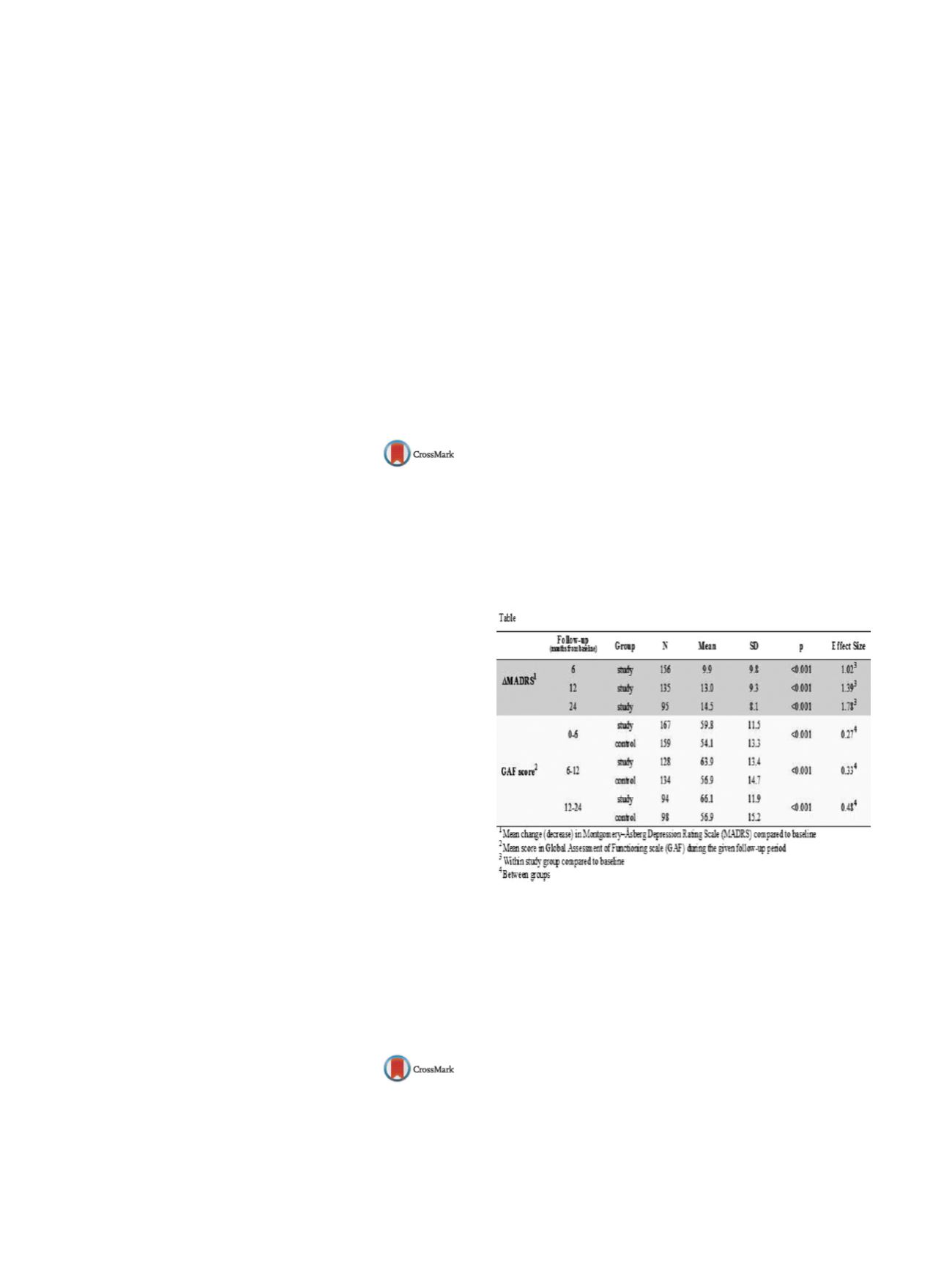

S532
25th European Congress of Psychiatry / European Psychiatry 41S (2017) S521–S582
Methods
Participants were 19 community-dwelling older adults
with StD assessed by the Center for Epidemiologic Studies Depres-
sion scale (CES-D) scores. We collected magnetic resonance images
of their brain compared to images of 18 healthy aged-matched
adults. We used SPM to analyze differences in brain activations in
emotional interference processing between the two groups.
Results
Results showed that elderly individuals with StD have
stronger activation in DLPFC, ACC, default mode network (DMN)
and visual extrastriate cortex compared to healthy controls. Fur-
thermore, the brain activations of the DLPFC, DMN and visual
extrastriate cortex were significantly associated with participants’
behavioral interference effect in StD.
Conclusions
Stronger brain activation in DLPFC, ACC, DMN and
extrastriate cortex in old adults with StD suggests that the working
efficiency of their brain is quite low and their cognitive control is
impaired to some extent.
Disclosure of interest
The authors have not supplied their decla-
ration of competing interest.
http://dx.doi.org/10.1016/j.eurpsy.2017.01.722EV0393
Clinico-psychopathological features
of the resistant depression
S. Lukmonov
∗
, N. Yadgarova
Tashkent Medical Academy, Psychiatry and Narcology, Tashkent,
Uzbekistan
∗
Corresponding author.
Objective
To study the clinical - psychopathological characteris-
tics of patients with resistant depression.
Materials and methods
We examined 96 patients aged 18–48
years (mean age 34.7 0
±
1.0 years). The investigated patients were
divided into two groups: 1st -TRD with positive affectivity - 59
(61.4%); 2nd - curable depression - 37 (38.6 %). Selection of patients
was made according to following criteria: ICD - 10: (F31) - bipolar
disorder; (F32) - depressive episode; (F33) - recurrent depressive
disorder.
Results
In group 1 patients received amitriptyline (TCA) - 50mg -
2 times/day in one of 2 consecutive courses (within 6 weeks)
and they showed no clinical benefit. In group 2 patients received
amitriptyline - 50mg 2 times/day for 2 consecutive courses.
When analyzing the number of depressive episodes the statisti-
cally greater number was observed 1-3 episodes in group 2 - in
45.9% of patients than in group 1 - 16.9%, predominant 5-8
episodes - in 44.1% of patients in group 1, than in group 2 -
13.5%. Remissions, observed in group 2, were characterized by
longer duration and have a higher quality than in patients of
group 1. There is a tendency to shorten remission especially in
group 1.
Conclusion
The highest correlation dependence showed such fac-
tors as: frequency of depressive episodes, duration of episode
1, severity of depressive episode 1, quality of remission after
depressive episode 1, number of responders at early stages of
antidepressant therapy of I-st attack.
Disclosure of interest
The authors have not supplied their decla-
ration of competing interest.
http://dx.doi.org/10.1016/j.eurpsy.2017.01.723EV0394
Comparison of behavioral activation
therapy and treatment as usual
among depressed patients in
secondary psychiatric care
K. Luoto
1 , 2 ,∗
, A. Koivukangas
1 , 2, A. Lassila
2, E. Leinonen
1,
O. Kampman
1 , 21
University of Tampere, Psychiatry, Tampere, Finland
2
The Hospital District of South Osthrobothnia, Psychiatry, Seinäjoki,
Finland
∗
Corresponding author.
Introduction
Evidence-based brief therapies are needed to
reduce a marked heterogeneity affecting treatment of depression
within the public psychiatric care. They should be easy to imple-
ment and use for a large group of patients.
Objectives
To develop and implement an effective brief treat-
ment protocol for depressed patients treated in public psychiatric
secondary care.
Aim
To explore and compare the outcome of depressed patients
receiving either behavioral activation therapy (BA) or treatment as
usual (TAU).
Methods
Two hundred and forty two depressive patients referred
to adult public secondary psychiatric care formed the BA treated
study group. The TAU treated control group (
n
= 205) was collected
from the hospital districts database and matched by the hospi-
talization rate, Alcohol Use Disorders Identification Test (AUDIT)
and Beck Depression Inventory (BDI). All patients received anti-
depressive medications. In the study group, Montgomery–Åsberg
Depression Rating Scale (MADRS) was conducted four times within
24 months follow-up. In both groups, the ability of functioning was
controlled by Global Assessment of Functioning scale (GAF).
Results
In the study group, depressive symptoms alleviated
systematically and significantly during follow-up
( Table 1 ).The
improvement in GAF scores was significantly better in the study
group throughout the follow-up
( Table 1 ).Conclusions
BA can be implemented and used effectively for
depressive patients in public psychiatric secondary care. BA is supe-
rior to TAU in terms of functional recovery.
Table 1
1
Mean change (decrease) in Montgomery–Åsberg Depression
Rating Scale (MADRS) compared to baseline.
2
Mean score in Global Assessment of Functioning scale (GAF)
during the given follow-up period.
3
Within study groups compared to baseline.
4
Between groups.
Disclosure of interest
The authors have not supplied their decla-
ration of competing interest.
http://dx.doi.org/10.1016/j.eurpsy.2017.01.724

















